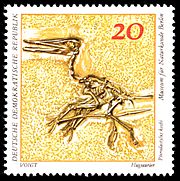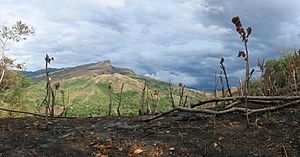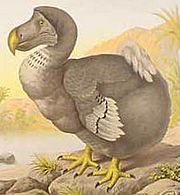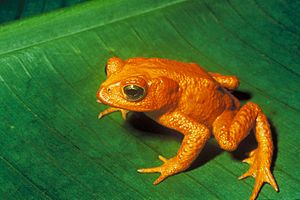Extinction facts for kids

Quick facts for kids Conservation status
|
|
|---|---|
 |
|
| Extinct | |
|
|
| Threatened | |
|
|
| Lower Risk | |
|
|
|
Other categories |
|
|
|
|
Related topics
|
|
 Comparison of Red list classes above and NatureServe status below  |
|
Extinction is one of the major features of evolution. A species is extinct when no members of the species are still alive.
All species become extinct sooner or later. The end of a species may happen for many reasons. It may be caused by habitat loss or by being overhunted, or by a major extinction event. An example of an animal that is now extinct is the Dodo, from over-hunting. Another quite different way for a species to end is by species-splitting, known as cladogenesis. Probably, none of the species living today was living in the Cambrian period, but their ancestors were.
Endangered species are those which may become extinct. A report from Kew Gardens suggests that one fifth of plant species may be at risk of extinction. Fossil species sometimes reappear millions of years after they were thought to be extinct. These cases are called Lazarus taxa.
Contents
Duration of species
The average duration of species varies according to the groups studied. A study of benthic (deep water) foraminifera showed an average of 16 million years if they lived above 200 metres, but 25my if they lived below 200 metres. On the other hand, the average survival time for mammalian species over the past 20my has been 2.33my.
It is estimated that 99.9% of all species that have ever lived are now extinct. More than half of the plants and animals that have become extinct in the last 200 years have been in Australia. There the arrival of Europeans with (accidentally or deliberately) introduced species has damaged the native biota. Especially, the introduction of eutherian mammals has caused the extinction of many marsupial forms.
Duration of higher groups
Naturally, higher categories such as genera, families, orders, classes and phyla last longer, because they are composed of more species. As far as we know, no phylum has gone completely extinct since the Cambrian, but quite a few classes went extinct in one or other of the 'big five' extinction events. Examples of higher categories of animal now extinct are: placoderm fish, trilobites, ammonites, pelycosaurs, non-avian dinosaurs, pterosaurs, ichthyosaurs and plesiosaurs.
Reasons
The Earth's environment can stay rather stable for long periods of time. Then the rate of extinction is usually quite low. Then changes occur, sometimes quite rapidly. In these times the rate of extinction can be much higher. The rate of extinction is therefore a useful thing to measure.
Genetics
Darwin thought that most extinctions occurred because some organisms became more effective, and replaced their less advanced competitors. No doubt that does occur, but the view now is that environmental change is more important. Organisms become adapted to the environments they live in. The environment certainly does change, and sometimes quite dramatically. When it does, some organisms can adapt to the changes. Others cannot.
Habitat degradation

Habitat degradation is currently the main anthropogenic cause of species extinctions. The main cause of habitat degradation worldwide is agriculture, with urban sprawl, logging, mining and some fishing practices close behind. The degradation of a species' habitat may alter the fitness landscape to such an extent that the species is no longer able to survive and becomes extinct. This may occur by direct effects, such as the environment becoming toxic, or indirectly, by limiting a species' ability to compete effectively for diminished resources or against new competitor species.
Habitat degradation through toxicity can kill off a species very rapidly, by killing all living members through contamination or sterilizing them. It can also occur over longer periods at lower toxicity levels by affecting life span, reproductive capacity, or competitiveness.
Habitat degradation can also take the form of a physical destruction of niche habitats. The widespread destruction of tropical rainforests and replacement with open pastureland is widely cited as an example of this; elimination of the dense forest eliminated the infrastructure needed by many species to survive. For example, a fern that depends on dense shade for protection from direct sunlight can no longer survive without forest to shelter it. Another example is the destruction of ocean floors by bottom trawling.
Diminished resources or introduction of new competitor species also often accompany habitat degradation. Global warming has allowed some species to expand their range, bringing unwelcome competition to other species that previously occupied that area. Sometimes these new competitors are predators and directly affect prey species, while at other times they may merely outcompete vulnerable species for limited resources. Vital resources including water and food can also be limited during habitat degradation, leading to extinction.
Predation, competition, and disease
In the natural course of events, species become extinct for a number of reasons, including but not limited to: extinction of a necessary host, prey or pollinator, inter-species competition, inability to deal with evolving diseases and changing environmental conditions (particularly sudden changes) which can act to introduce novel predators, or to remove prey. Recently in geological time, humans have become an additional cause of extinction (many people would say premature extinction) of some species, either as a new mega-predator or by transporting animals and plants from one part of the world to another. Such introductions have been occurring for thousands of years, sometimes intentionally (e.g. livestock released by sailors on islands as a future source of food) and sometimes accidentally (e.g. rats escaping from boats). In most cases, the introductions are unsuccessful, but when an invasive alien species does become established, the consequences can be catastrophic. Invasive alien species can affect native species directly by eating them, competing with them, and introducing pathogens or parasites that sicken or kill them; or indirectly by destroying or degrading their habitat. Human populations may themselves act as invasive predators. According to the "overkill hypothesis", the swift extinction of the megafauna in areas such as Australia (40,000 years before present), North and South America (12,000 years before present), Madagascar, Hawaii (300–1000 CE), and New Zealand (1300–1500 CE), resulted from the sudden introduction of human beings to environments full of animals that had never seen them before, and were therefore completely unadapted to their predation techniques.
Coextinction
Coextinction refers to the loss of a species due to the extinction of another; for example, the extinction of parasitic insects following the loss of their hosts. Coextinction can also occur when a species loses its pollinator, or to predators in a food chain who lose their prey. "Species coextinction is a manifestation of the interconnectedness of organisms in complex ecosystems ... While coextinction may not be the most important cause of species extinctions, it is certainly an insidious one". Coextinction is especially common when a keystone species goes extinct. Models suggest that coextinction is the most common form of biodiversity loss. There may be a cascade of coextinction across the trophic levels. Such effects are most severe in mutualistic and parasitic relationships. An example of coextinction is the Haast's eagle and the moa: the Haast's eagle was a predator that became extinct because its food source became extinct. The moa were several species of flightless birds that were a food source for the Haast's eagle.
Climate change
Extinction as a result of climate change has been confirmed by fossil studies. Particularly, the extinction of amphibians during the Carboniferous Rainforest Collapse, 305 million years ago. A 2003 review across 14 biodiversity research centers predicted that, because of climate change, 15–37% of land species would be "committed to extinction" by 2050. The ecologically rich areas that would potentially suffer the heaviest losses include the Cape Floristic Region, and the Caribbean Basin. These areas might see a doubling of present carbon dioxide levels and rising temperatures that could eliminate 56,000 plant and 3,700 animal species.
Mass extinctions
There have been at least five mass extinctions in the history of life on earth, and four in the last 350 million years in which many species have disappeared in a relatively short period of geological time. A massive eruptive event is considered to be one likely cause of the "Permian–Triassic extinction event" about 250 million years ago, which is estimated to have killed 90% of species then existing. There is also evidence to suggest that this event was preceded by another mass extinction, known as Olson's Extinction. The Cretaceous–Paleogene extinction event (K-Pg) occurred 66 million years ago, at the end of the Cretaceous period, and is best known for having wiped out non-avian dinosaurs, among many other species.
Related pages
Images for kids
-
The Tasmanian tiger (Thylacinus cynocephalus) is an example of an extinct species.
-
External mold of the extinct Lepidodendron from the Upper Carboniferous of Ohio
-
The dodo of Mauritius, shown here in a 1626 illustration by Roelant Savery, is an often-cited example of modern extinction.
-
The passenger pigeon, one of the hundreds of species of extinct birds, was hunted to extinction over the course of a few decades.
-
Tyrannosaurus, one of the many extinct dinosaur genera. The cause of the Cretaceous–Paleogene extinction event is a subject of much debate amongst researchers.
-
Georges Cuvier compared fossil mammoth jaws to those of living elephants, concluding that they were distinct from any known living species.
-
A great hammerhead caught by a sport fisherman. Human exploitation now threatens the survival of this species. Overfishing is the primary driver of shark population declines, which have fallen over 71% since 1970.
See also
 In Spanish: Extinción para niños
In Spanish: Extinción para niños












